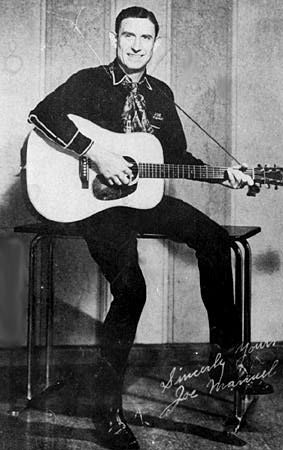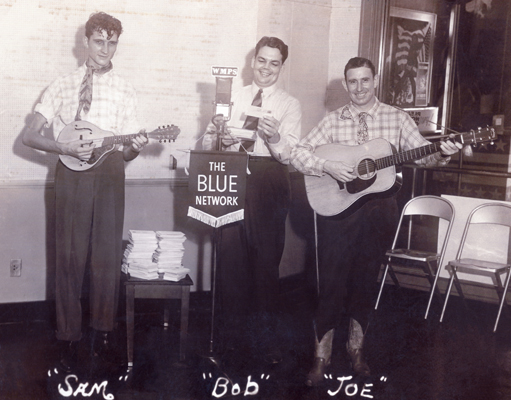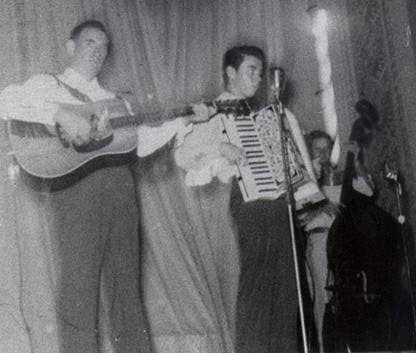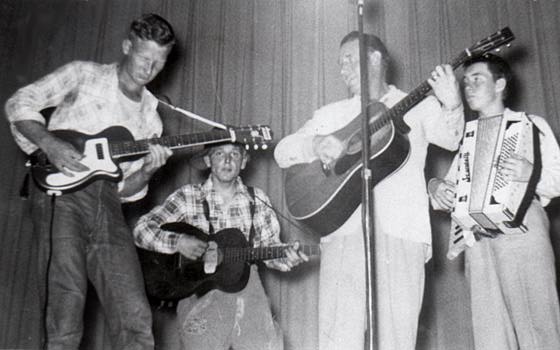Joe Manuel
JOE MANUEL, 1938 radio station publicity photograph.
©Larry J. Manuel
Joe Manuel was born in rural Alabama. He moved to the Arkansas delta with his family as a young boy and was raised on farms in the area until he was a teenager. His family were sharecroppers. When he was a teenager, he left home and started his career in show business by joining a carnival. A vaudeville comedian by the name of Dave Perkins took Joe under his wing and taught him the art of entertaining an audience. Joe learned to play the guitar and sing.
In the early thirties, Joe was performing on radio stations in the Arkansas Delta country. By 1933 Joe had moved to Memphis and was broadcasting on W.N.B.R. Later the station was bought by the Memphis Press Scimitar and the call letters changed to W.M.P.S. The station also became the Memphis affillate of the Blue Network, which was the forerunner of A.B.C.
Left to right: Sam Baird - Bob Neal - Joe Manuel. Sam Baird {Joe Manuel's mandolin player} became well known in Europe, in the 1970s and 80s, as bassman in the Country Rockers Band. They made three albums for New Rose Records in France and had several sussessful tours in Europe. Local news outlets reported that they performed in front of 80,000 people at a mega-festival in Sweden. - Bob Neal {Joe Manuel's network radio announcer} became Elvis Presley's manager in the 1950s, prior to Col. Tom Parker. Notice the weekly stack of fan mail on the table between Sam and Bob. Joe Manuel was reputed to have receieved over a thousand letters a week during his time on the Blue Network. This picture was made prior to World War Two.
For a period of time Joe Manuel's broadcasts were carried on the Blue Network - Prior to World War 2. In the middle forties, Joe moved to Dallas Texas and began broadcasting on a radio station there. The station's call letters are unknown because so much time has passed, but the station made Joe an offer he couldn't refuse. After a short period of time, because of family matters, he returned to Memphis. He was immediately hired by W.H.B.Q., where he stayed until 1950.
Freddie Burns, a historian of WHBQ and a former radio star of that era, relates this story: "When WHBQ changed owners in the middle forties, they increased their power from 500 watts to 5000 watts. Since the station was at the lower end of the band (56 on the dial), it had a much stronger signal than had it been on the higher end of the band ... say 1000, 1250 or 1400."
At this time, WHBQ moved Joe's broadcast to the 5:30 am slot. His show would be broadcast between 5:30 and 6:00 am daily. When Joe's show was moved to this time slot, it became one of the most popular radio programs in the south at that time. What happened was the farmers around the countryside would get up around 4:00 to 4:30 am to do their chores and come in to eat breakfast about 5:30. They would turn their radios to 56 on the dial and listen to Joe's broadcast with their families while they ate their breakfast.
LEFT to RIGHT: Joe Manuel, Larry Manuel and Marcus Van Story. This 1954 photo shows Marcus easing out on stage to sit in with the Joe Manuel Band. Joe and Marcus were old friends and Marcus loved working on stage with Joe.
©Larry J. Manuel
This show built up a tremendous listener following. Joe received fan mail from Georgia, Louisiana, the panhandle of Florida, Illinois, Kentucky and points east and west. That 5000 watt station was blasting out all over the south. There were not that many radio stations the time, and being that early in the morning and being that low on the band, they had tremendous coverage. During this time WHBQ ran a promotional event to promote their shows. They would send out pictures of the radio stars if the listeners would write in and request them. Freddie Burns says that during this event WHBQ was receiving over a thousand letters a day for Joe's pictures. Sometimes Joe would take his band out for personal appearances and they would draw huge crowds.During this period, the people who handled the advertising for the Holsum Bread Company approached Joe about writing a commercial jingle. Joe wrote and recorded "Holsum Bread Boogie." a full length song which the advertisers condensed into a commercial. The jingle became so popular in Southern Illinois that the Holsum Bread Company brought Joe and his band up to Anna Illinois to do a show. He walked on stage in front of 11,000 people. It was a tremendous crowd for a country music singer in the forties.
Television cam to Memphis in 1948 and the popularity of the radio shows, in general, faded quickly. Joe did not make the transition to television and ceased broadcasting his show in 1950. He stayed out of broadcasting for about two years, then moved across the river to KWEM in West Memphis, Arkansas and started doing a daily radio broadcast on this station. He stayed with this station off and on until his death in 1959.
Jimmy Rodgers was a hero of Joe's and his influences can be heard in some of Joe's music, particularly "Alimony Blues." which Joe wrote and introduced on his radio broadcast around 1940. It became his most requested song. Joe was renowned as an accomplished yodeler and was the inventor of the Four Triple Swiss yodel.
In 1950, because of the vast amount of talent in Memphis, Joe convinced the idea of a stage show similar to the Grand Ole Opry in Nashville. He wanted to bring this talent to the attention of the public. Out of this idea was born the Saturday Night Jamboree at the old Goodwyn Institute Auditorium at Third and Madison. The Saturday Night Jamboree ran for two years (1953-54), and a lot of young Memphis musicians made some of their first public appearances on this show. A unique thing about this was - that the young players and singers that appeared were going into the recording studios that had recently sprung up all over town. The artists were experimenting with their new found sounds. This sound combined country, blues and gospel. The world would soon call it "rockabilly." Some of these singers and musicians would go on to become legends in the music industry.
Joe's stage presence was strong and he knew how to entertain an audience. Whether he walked out on stage with his band or with just his guitar, his ability to hold an audience is still talked about today by old timers in the music business. Joe's medium was live radio, therefore, there is very little recorded material today with his voice on it.
If Joe left a legacy, it was the inspiration that he gave to the young musicians of that era to do the best that they could do when they walked up to this microphone and the spotlight fell upon their shoulders.
Recently the State of Arkansas erected an historical marker in front of the building in West Memphis, that housed the k.w.e.m. studios until 1955. The Marker is dedicated to k.w.e.m. radio for the period 1949-1955. There is a picture of Joe and his band on the front of the Marker.
LEFT to RIGHT: Major Pruitt, Robt. "Droopy" Howard, Joe Manuel and Larry Manuel. Major Pruitt flashes some of the new sounds being developed backstage on the break in a Joe Manuel song. This 1953 photos captures what was probably some of the earliest moments that the sounds that became known as "rockabilly" were played in front of a live audience.
©Larry J. Manuel
ALSO SEE:
"SATURDAY NIGHT JAMBOREE" Memphis Page
"The 'Saturday Night Jamboree' was probably where the first live rockabilly was performed."
"Rockabilly Hall of Fame"
"Traditional Country Hall of Fame"
Place Your Website Within These Pages
© 2001 - Traditional Country Hall of Fame





